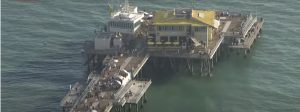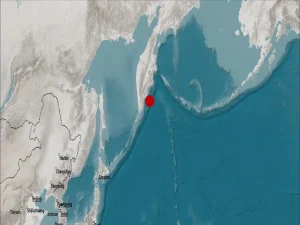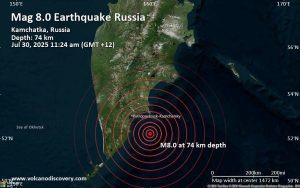Russia – First Tsunami Waves Hit Russia coast along the Severo-Kurilsk region, marking the beginning of widespread oceanic disruption following the devastating 8.7 magnitude earthquake that struck off the Kamchatka Peninsula. The immediate impact of these waves created alarming scenes as coastal infrastructure faced the full force of the tsunami’s destructive power.
Reports confirmed that First Tsunami Waves Hit Russia shoreline within hours of the initial seismic event, demonstrating the rapid propagation of tsunami energy across the Pacific Ocean. The Severo-Kurilsk region, known for its vulnerability to such natural disasters, bore the brunt of the initial wave impact.
Social Media Documents Tsunami Destruction


Dramatic footage shared on social media platforms captured the moment when First Tsunami Waves Hit Russia coastal areas, showing structures being completely overrun by rapidly rising sea levels. These videos provided real-time documentation of the tsunami’s devastating impact on Russian coastal communities.
The visual evidence of when First Tsunami Waves Hit Russia revealed the overwhelming power of nature as buildings and infrastructure succumbed to the advancing waters. Social media users shared compelling before-and-after images taken from elevated positions, clearly showing the dramatic transformation of the landscape as tsunami waters engulfed previously dry areas.
Aerial Perspectives Reveal Complete Transformation

Aerial stills documented the stark contrast between normal coastal conditions and the aftermath when First Tsunami Waves Hit Russia territory. These elevated viewpoints provided crucial perspective on the scale of inundation, showing how entire coastal sections disappeared under the advancing tsunami waters.
The comparative imagery from when First Tsunami Waves Hit Russia demonstrated the rapid and complete transformation of the coastal landscape. Areas that appeared normal and inhabited in pre-tsunami photographs were completely submerged within minutes of the waves’ arrival, highlighting the tsunami’s incredible destructive capacity.
Severo-Kurilsk’s Geological Vulnerability
The region where First Tsunami Waves Hit Russia is historically known for its intense volcanic and seismic activity, making it particularly susceptible to both earthquakes and subsequent tsunami events. This geological instability creates ongoing risks for coastal communities throughout the area.
Severo-Kurilsk’s location makes it a frequent target when First Tsunami Waves Hit Russia following major seismic events. The area’s position along active fault lines and its proximity to underwater geological formations contribute to its heightened vulnerability to tsunami damage.
Rising Sea Levels Overwhelm Infrastructure


Videos clearly showed how First Tsunami Waves Hit Russia coastal structures with overwhelming force, as rising sea levels completely inundated buildings and other infrastructure. The rapid water level increase left no time for emergency evacuation of vulnerable structures.
The footage revealed that when First Tsunami Waves Hit Russia shoreline, the water levels rose so dramatically that even elevated structures faced significant flooding risks. This rapid inundation pattern is characteristic of powerful tsunamis generated by major offshore earthquakes.
International Tsunami Alert Systems Activated
Following reports that First Tsunami Waves Hit Russia, international monitoring agencies immediately activated tsunami warning systems across the Pacific region. Japan and several US states, including California, Washington, Oregon, and Alaska, were placed under tsunami watch as waves began propagating eastward across the Pacific Ocean.
The confirmation that First Tsunami Waves Hit Russia triggered heightened alert levels throughout the Pacific Rim, as authorities prepared for potential wave impacts in other coastal regions. Tsunami modeling indicated that waves could reach heights of up to three meters when they eventually reach Japanese and American coastlines.
Predicted Wave Heights Raise Concerns
Tsunami experts predict that waves measuring up to three meters in height will impact Japan and US coastal areas in the coming hours, following the initial confirmation that First Tsunami Waves Hit Russia. These projected wave heights pose significant risks to coastal infrastructure and populations.
The progression from when First Tsunami Waves Hit Russia to potential impacts on other Pacific nations demonstrates the far-reaching effects of major seismic events. Wave energy continues to travel across the ocean at high speeds, maintaining dangerous heights even thousands of kilometers from the original earthquake epicenter.
Emergency Preparedness Across Pacific Region
The visual confirmation that First Tsunami Waves Hit Russia prompted immediate emergency preparedness measures across multiple Pacific nations. Coastal authorities in Japan and the United States began implementing evacuation procedures and safety protocols based on the tsunami’s documented impact in Russian territory.
Observing how First Tsunami Waves Hit Russia provided crucial data for predicting similar impacts in other regions. Emergency management officials used this real-time information to refine their response strategies and issue more accurate warnings to potentially affected populations.
Ongoing Monitoring and Assessment


As rescue and assessment teams respond to areas where First Tsunami Waves Hit Russia, continuous monitoring of wave propagation across the Pacific Ocean remains critical. The initial impact serves as a stark reminder of tsunami destructive power and the importance of maintaining robust early warning systems throughout seismically active regions.
The documentation of when First Tsunami Waves Hit Russia will provide valuable scientific data for improving future tsunami prediction models and emergency response protocols across the Pacific Ring of Fire.

